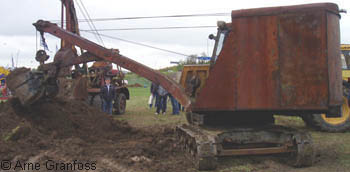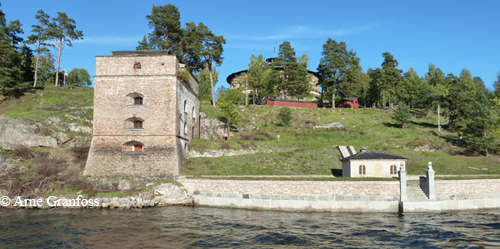Where is Sweden? History?

 UNDER CONSTRUCTION Version 0.41
UNDER CONSTRUCTION Version 0.41
|
Sweden in World War II - across borders
|
 |
Sweden is situated in the north of Europe. The Arctic circle is approximately along the blue line in the map. The Swedish coast is around 2,700 kilometres long [s72]. Sweden's borders:
 To Finland: The northeast of Sweden has a land border towards Finland, otherwise the countries are separated by the Gulf of Bothnia in the Baltic Sea all the way down south of the group of islands Åland that belong to Finland.
To Finland: The northeast of Sweden has a land border towards Finland, otherwise the countries are separated by the Gulf of Bothnia in the Baltic Sea all the way down south of the group of islands Åland that belong to Finland.
To not-Nordic countries: The southern half of Sweden has Estonia, Latvia and Lithuania to the east, separated by the Baltic Sea. The larger island Gotland is a part of Sweden. To the south are Poland and Germany, also separated by the Baltic Sea.
To Denmark (Danmark): Denmark is situated to the west of the southern end of Sweden. The countries are separated by water, Kattegatt, but the sound is so narrow that you can see Denmark from areas in Sweden. The island Bornholm straight to the south of Sweden is also Danish.
To Norway (Norge): After a short distance of border in the waters between southern Sweden and Norway, there is a 1600 kilometres long border all the way up to the northern end of Sweden. From the south this border passes mainly forests and through some lakes, and further north through the Scandinavian mountains. (Norway continues north of Finland, and has a border to the Soviet Union. Around the end of WWII Finland lost the area around Petsamo to the Soviet Union.)
To the Atlantic Ocean: The seaway to the Atlantic Ocean is the sound Skagerak between Denmark and Norway.
Other borders: On this web site I use a wider view of borders - including activities performed by Swedes in other countries, and foreigners in Sweden.
 Some distances:
Some distances:
The sign to the right is placed in Smygehuk, the southernmost mainland in Sweden. Treriksröset is the northernmost place in Sweden, where the borders between Finland, Norway and Sweden meet.
Some words and other information
Seasons: roughly the springtime in Scandinavia is in March-May and the autumn in September-November.
Some sun information (2012):
Scandinavia: A common word for Denmark, Norway and Sweden. (Sometimes it is used including Finland, and sometimes as a synonym to Norden.)
Norden/Nordic: The five countries Denmark, Finland, Iceland, Norway and Sweden. Before World War II Iceland was an independent state in union with Denmark, and negotiations about the future of this union had been planned to take place in 1940. In 1944 Iceland proclaimed itself a free republic. [s15]
Sweden’s capital is Stockholm. Denmarks capital is København (Copenhagen in English), and Finlands Helsinki (Helsingfors in Swedish). Norway’s capital is Oslo.
The Swedish city Göteborg is named Gothenburg in English.
"Government", "Sweden" and similar: I use these words for government, parliament and more. Often I just write Sweden. It's the same with other nations.
Sweden and Finland
Until 1809 Finland and Sweden had a common history [s25]. The early Sweden began somewhere in the southern third of present day Sweden, with a number of wars over centuries until a strong enough central power had been established. The growing Sweden expanded over time both northwards, and eastwards across the Baltic Sea. Todays Finland became a part of Sweden in peaceful ways (before it was a nation), among others with Swedish missionaries who spread Christianity (as far as I understand now).
Sweden took part in many of the wars in Europe, and Russia often was on the opposing side. (But in 1610, when Russian Tsar Vasilijs enemies beleaguered Moscow, a Swedish force marched there to his aid. The beleaguering forces, among others Polish, retreated. On 12 March the Swedish force marched into Moscow, and a two year long siege was over.)

Fredriksborg Fortress, in the Stockholm archipelago - constructed 1724-1735 to increase protection of Stockholm after Russian coastal raids.

Sveaborg at Helsinki, Finland - as finished in 1772, when Finland still was a part of Sweden.
In the peace negotiations in Fredrikshamn in 1809 Finland was separated from Sweden, and became a rather self-governing part of Russia. The Russian Tsar Alexander I accepted that Finland in large continued to follow its own constitution, which was the Swedish constitution from 1772 with addition in 1789. In December 1917 Finland declared independency. [s25]
However, the border discussions about the islands Åland (between Finland and Sweden) were not settled until in 1921 [s09]. In 1938 new discussions began. [s18]
When the Soviet Union attacked Finland, there was a strong feeling in Sweden that “Finlands matter is ours”. Communications were easier since 6-7 % of Finlands population have Swedish as basic language.
Sweden, Denmark and Norway

Eketorp stronghold - on the eastern island Öland, as it may have been in 400-700.

Trelleborgen - built around year 980, when southern Sweden was Danish.

Bohus fortress was founded in 1308 by the Norwegians, who lost it to Sweden in the Roskilde peace 1658. It has lived through fourteen bloody sieges.
People in present day Norway and Denmark had several feuds in southern Norway, but in 1163 or 1164 a Norwegian King was crowned – the first crowning of a King in the Nordic countries. But feuds continues. A part of present day Sweden was Danish territory, and for centuries there were lots of feuds and wars in Scandinavia. In 1319 Magnus Eriksson became a Norwegian and Swedish King. Feuds and wars continued. One period a Union with Denmark, Norway and Sweden. Then Denmark occupied Sweden as far north as Uppsala, including Stockholm. Later Norway was Danish, and later Sweden occupied Denmark. For centuries there were wars in Scandinavia in all possible constellations, sometimes with involvement from German or other foreign persons and groups. Sweden also took part in several European wars. The borders between the three countries changed over and over again. [s03]
(Between the late 16th century to the early 18th century approximately 50 000 Finnish immigrated to Sweden, to begin farming in then uninhabited woodlands foremost in Värmland in western Sweden [s32]. The area where the immigrants settled was called Finnmarker [s32]. In Norway the area Finnskogene was mostly populated by Finnish immigrants for 240 years [s33]. At a border regulation in the 17th century, the Finnish who lived in the Swedish area Røgden decided that they wanted to be Norwegians instead [s33].)

Kalmar Castle - as it looked around 1600 (very roughly), when Danes attacked Kalmar.
In 1812 Sweden became an allied state with Russia in the war against Napoleon, and was promised Norway. British ships attacked in northern Norway. After the defeat of Napoleon, Sweden won over Denmark. The peace treaty in Kiel 1814 resulted in among others an exchange of the Swedish Pommern with Norway. The new situation with a union between Norway and Sweden did not start with friendly feelings, but with the Danish Prince Kristian Fredrik chosen by Norway as their King – and a war followed that Sweden won. Peace followed with a union between Norway and Sweden, and Norway changed the constitution among others since the King would be Swedish. [s03]

Vaxholm Fortress, in the Stockholm archipelago to protect Stockholm - as rebuilt in 1863.
More than 1 000 000 persons emigrated from Sweden 1865-1914, most of them between 15 and 35 years old - that was about 20 % of the entire Swedish population [s34]. And the emigration continued.
In 1905 it was close to war again, as Norway strived more eagerly for independence, but diplomatic efforts won that time. The union terminated in 1905, and the Danish Prince Carl became the Norwegian King Haakon 7. He was king of Norway until 1957. [s03]
Even though there were many good relationships and friendships across the border between Sweden and Norway, there was another historic background than between Sweden and Finland.
Nordkalotten
Nordkalotten is a name for the Arctic area of Finland, Norway, Sweden and the Kola Peninsula in Russia. When these nations were formed, Nordkalotten was a remote area that was more loosely knit to the respective nation. The people who lived in the area was named among others Fenni, Sameh (Sami) and Lapps.
Finnmarken is an elder name for the area in northern Scandinavia and Finland. The Swedish border to Russia was agreed in 1595. In 1613, after a war with Denmark, Sweden had to end the claims for coastal areas. The border between Sweden and Norway was set in 1751, and between Sweden-Finland and Russia in 1826. [s32]
Around 1500-1520 Sami killed many farmers in Norway, among others in Nordli (east of Namsos, at the present border to Sweden). [s33]
In Sweden, it wasn’t until 1673 with the book “Lapponia” that the culture of the Lapps was described in a historic view. The christianize took place in the 17th and early 18th century, partly by force. [s30]
In the 17th century farmers from southern Sweden moved to river valleys in the north, and farming got more common. [s31]
Iron ore mining began in the 17th century, and the mine in Gällivare was opened in 1742. Mining in larger scale began in the late 19th century, foremost in Kiruna in 1898. The construction of hydroelectric power stations began in the same period. [s31]
The first attempt to construct the railway for transport of iron ore from Luleå in Sweden to Narvik in Norway began in 1864, with British financial interests. The company went bankrupt in 1867, and left no tracks. The next company, also with British funding, managed to finish the distance Luleå-Gällivare in 1888 before they went bankrupt. Then the Swedish government took over, and the complete railway line was opened in 1903. [s55]
Much of the Finnish area of Nordkalotten became a part of the Soviet Union during World War II (1944 and 1947), among others the Arctic Ocean port Petsamo. [s31]
Another piece of history
During the 'Thirty Years' War Swedish troops fought in several parts of Germany, among others at Nürnberg and Frankfurt am Main in 1632. [s40]
2019-04-07. www.granfoss.se. Text/pictures: Arne Granfoss